Financial and Economic Literacy for Managers
VerifiedAdded on 2023/04/23
|20
|3811
|263
AI Summary
This report discusses the concepts of consumer sovereignty, market structure, demand and supply, profit maximization, wealth maximization, and business economic concepts. It also provides an example of Tesco Company in the Oligopoly Market Structure. The report is useful for managers to understand the principles of economics and financial management. The document type is a report and the type of assignment is a study material.
Contribute Materials
Your contribution can guide someone’s learning journey. Share your
documents today.
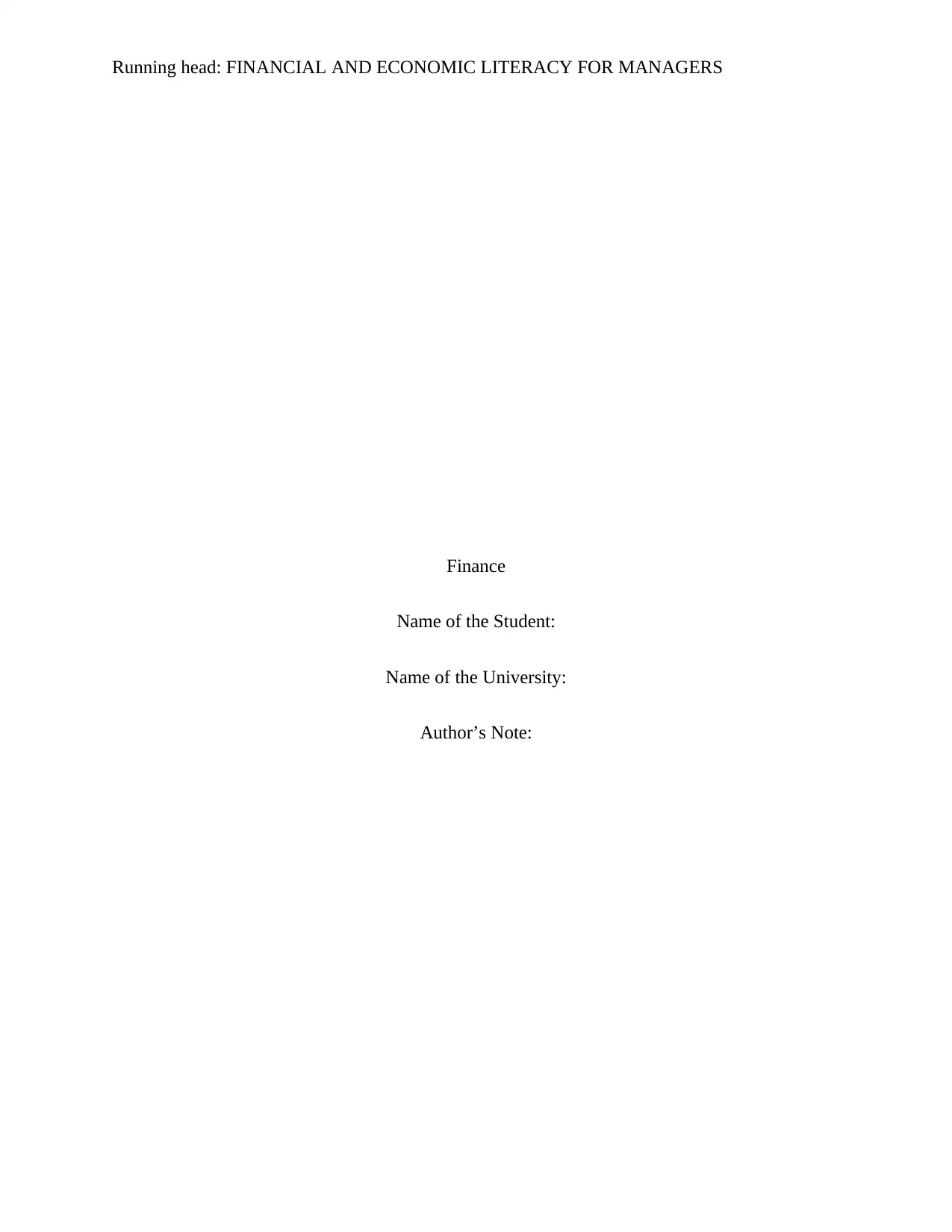
Running head: FINANCIAL AND ECONOMIC LITERACY FOR MANAGERS
Finance
Name of the Student:
Name of the University:
Author’s Note:
Finance
Name of the Student:
Name of the University:
Author’s Note:
Secure Best Marks with AI Grader
Need help grading? Try our AI Grader for instant feedback on your assignments.
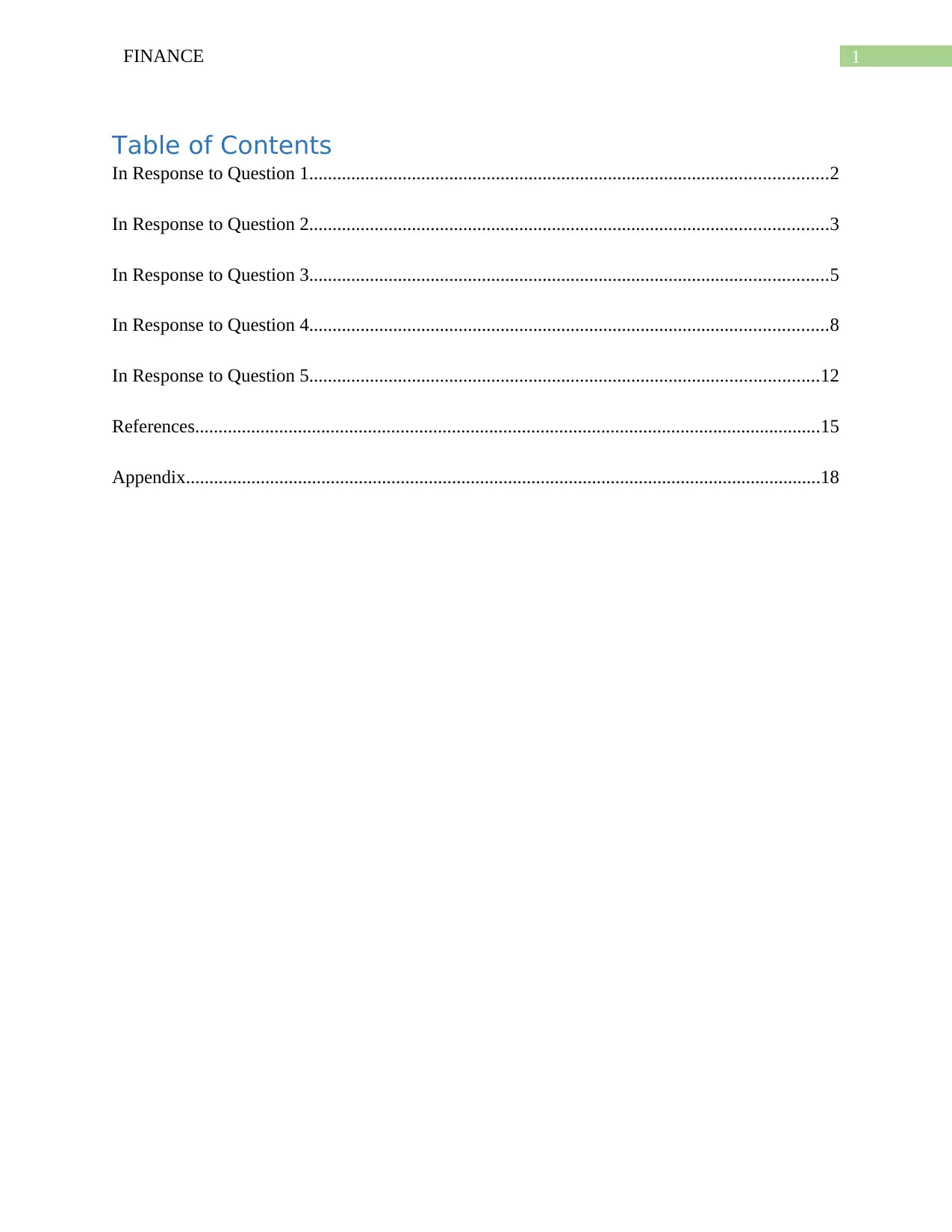
1FINANCE
Table of Contents
In Response to Question 1...............................................................................................................2
In Response to Question 2...............................................................................................................3
In Response to Question 3...............................................................................................................5
In Response to Question 4...............................................................................................................8
In Response to Question 5.............................................................................................................12
References......................................................................................................................................15
Appendix........................................................................................................................................18
Table of Contents
In Response to Question 1...............................................................................................................2
In Response to Question 2...............................................................................................................3
In Response to Question 3...............................................................................................................5
In Response to Question 4...............................................................................................................8
In Response to Question 5.............................................................................................................12
References......................................................................................................................................15
Appendix........................................................................................................................................18
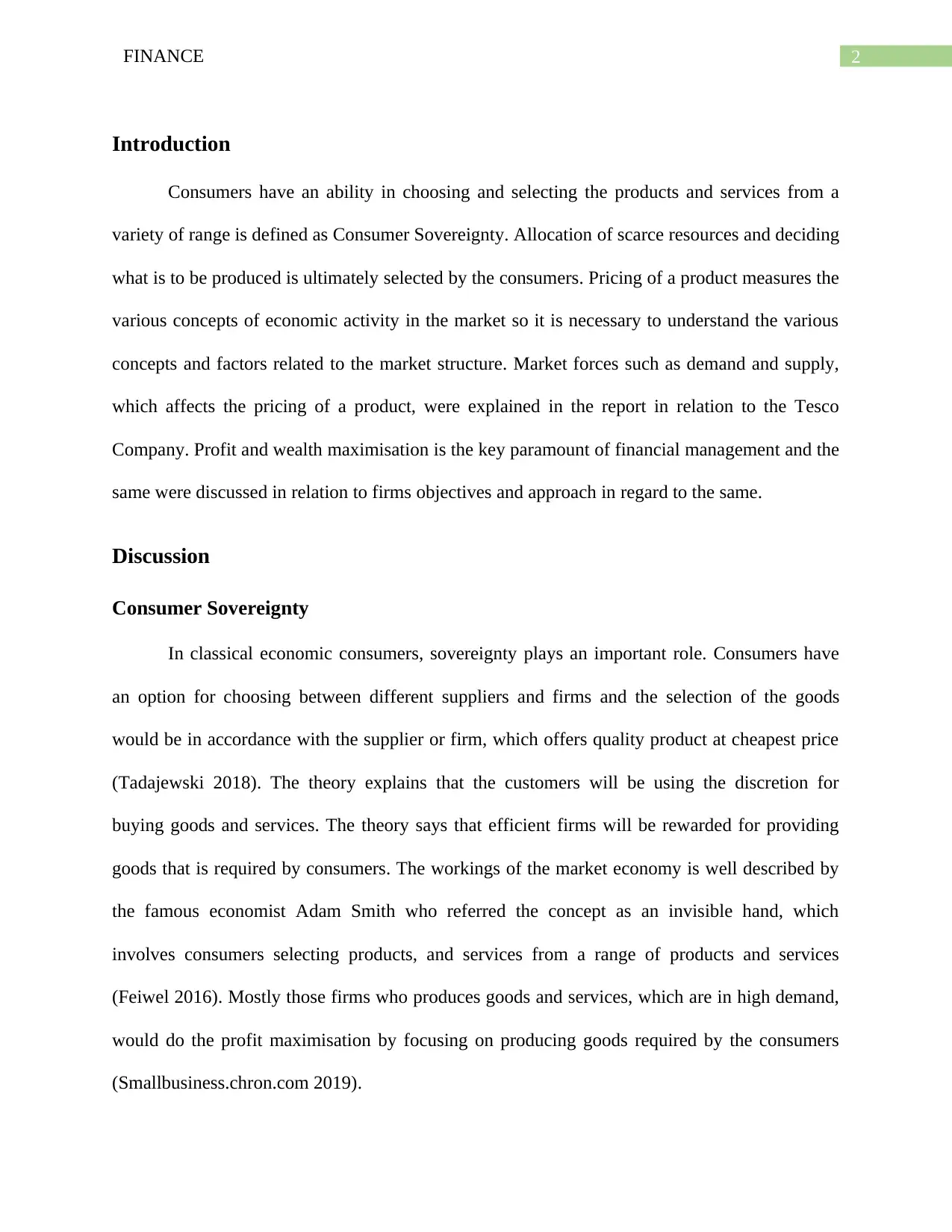
2FINANCE
Introduction
Consumers have an ability in choosing and selecting the products and services from a
variety of range is defined as Consumer Sovereignty. Allocation of scarce resources and deciding
what is to be produced is ultimately selected by the consumers. Pricing of a product measures the
various concepts of economic activity in the market so it is necessary to understand the various
concepts and factors related to the market structure. Market forces such as demand and supply,
which affects the pricing of a product, were explained in the report in relation to the Tesco
Company. Profit and wealth maximisation is the key paramount of financial management and the
same were discussed in relation to firms objectives and approach in regard to the same.
Discussion
Consumer Sovereignty
In classical economic consumers, sovereignty plays an important role. Consumers have
an option for choosing between different suppliers and firms and the selection of the goods
would be in accordance with the supplier or firm, which offers quality product at cheapest price
(Tadajewski 2018). The theory explains that the customers will be using the discretion for
buying goods and services. The theory says that efficient firms will be rewarded for providing
goods that is required by consumers. The workings of the market economy is well described by
the famous economist Adam Smith who referred the concept as an invisible hand, which
involves consumers selecting products, and services from a range of products and services
(Feiwel 2016). Mostly those firms who produces goods and services, which are in high demand,
would do the profit maximisation by focusing on producing goods required by the consumers
(Smallbusiness.chron.com 2019).
Introduction
Consumers have an ability in choosing and selecting the products and services from a
variety of range is defined as Consumer Sovereignty. Allocation of scarce resources and deciding
what is to be produced is ultimately selected by the consumers. Pricing of a product measures the
various concepts of economic activity in the market so it is necessary to understand the various
concepts and factors related to the market structure. Market forces such as demand and supply,
which affects the pricing of a product, were explained in the report in relation to the Tesco
Company. Profit and wealth maximisation is the key paramount of financial management and the
same were discussed in relation to firms objectives and approach in regard to the same.
Discussion
Consumer Sovereignty
In classical economic consumers, sovereignty plays an important role. Consumers have
an option for choosing between different suppliers and firms and the selection of the goods
would be in accordance with the supplier or firm, which offers quality product at cheapest price
(Tadajewski 2018). The theory explains that the customers will be using the discretion for
buying goods and services. The theory says that efficient firms will be rewarded for providing
goods that is required by consumers. The workings of the market economy is well described by
the famous economist Adam Smith who referred the concept as an invisible hand, which
involves consumers selecting products, and services from a range of products and services
(Feiwel 2016). Mostly those firms who produces goods and services, which are in high demand,
would do the profit maximisation by focusing on producing goods required by the consumers
(Smallbusiness.chron.com 2019).
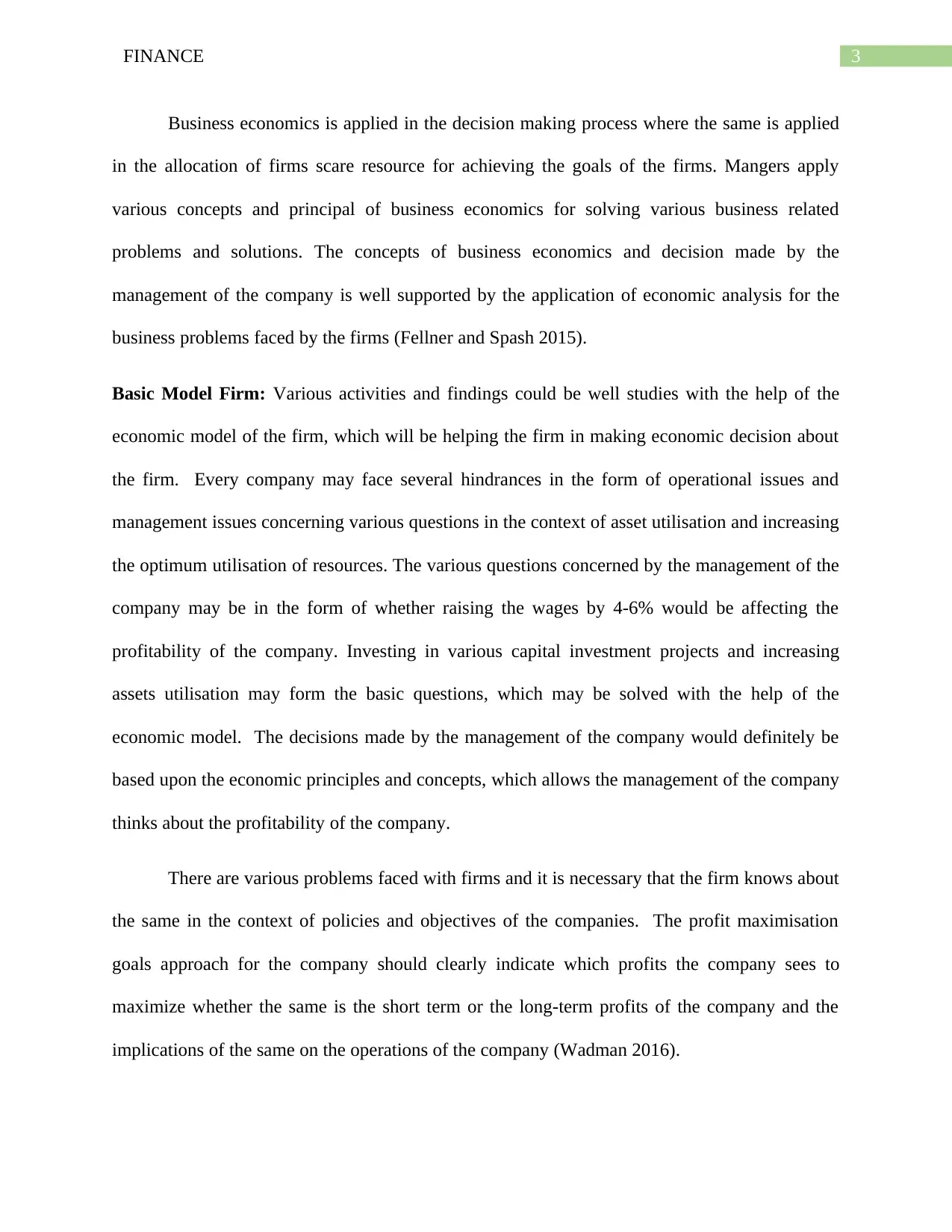
3FINANCE
Business economics is applied in the decision making process where the same is applied
in the allocation of firms scare resource for achieving the goals of the firms. Mangers apply
various concepts and principal of business economics for solving various business related
problems and solutions. The concepts of business economics and decision made by the
management of the company is well supported by the application of economic analysis for the
business problems faced by the firms (Fellner and Spash 2015).
Basic Model Firm: Various activities and findings could be well studies with the help of the
economic model of the firm, which will be helping the firm in making economic decision about
the firm. Every company may face several hindrances in the form of operational issues and
management issues concerning various questions in the context of asset utilisation and increasing
the optimum utilisation of resources. The various questions concerned by the management of the
company may be in the form of whether raising the wages by 4-6% would be affecting the
profitability of the company. Investing in various capital investment projects and increasing
assets utilisation may form the basic questions, which may be solved with the help of the
economic model. The decisions made by the management of the company would definitely be
based upon the economic principles and concepts, which allows the management of the company
thinks about the profitability of the company.
There are various problems faced with firms and it is necessary that the firm knows about
the same in the context of policies and objectives of the companies. The profit maximisation
goals approach for the company should clearly indicate which profits the company sees to
maximize whether the same is the short term or the long-term profits of the company and the
implications of the same on the operations of the company (Wadman 2016).
Business economics is applied in the decision making process where the same is applied
in the allocation of firms scare resource for achieving the goals of the firms. Mangers apply
various concepts and principal of business economics for solving various business related
problems and solutions. The concepts of business economics and decision made by the
management of the company is well supported by the application of economic analysis for the
business problems faced by the firms (Fellner and Spash 2015).
Basic Model Firm: Various activities and findings could be well studies with the help of the
economic model of the firm, which will be helping the firm in making economic decision about
the firm. Every company may face several hindrances in the form of operational issues and
management issues concerning various questions in the context of asset utilisation and increasing
the optimum utilisation of resources. The various questions concerned by the management of the
company may be in the form of whether raising the wages by 4-6% would be affecting the
profitability of the company. Investing in various capital investment projects and increasing
assets utilisation may form the basic questions, which may be solved with the help of the
economic model. The decisions made by the management of the company would definitely be
based upon the economic principles and concepts, which allows the management of the company
thinks about the profitability of the company.
There are various problems faced with firms and it is necessary that the firm knows about
the same in the context of policies and objectives of the companies. The profit maximisation
goals approach for the company should clearly indicate which profits the company sees to
maximize whether the same is the short term or the long-term profits of the company and the
implications of the same on the operations of the company (Wadman 2016).
Secure Best Marks with AI Grader
Need help grading? Try our AI Grader for instant feedback on your assignments.
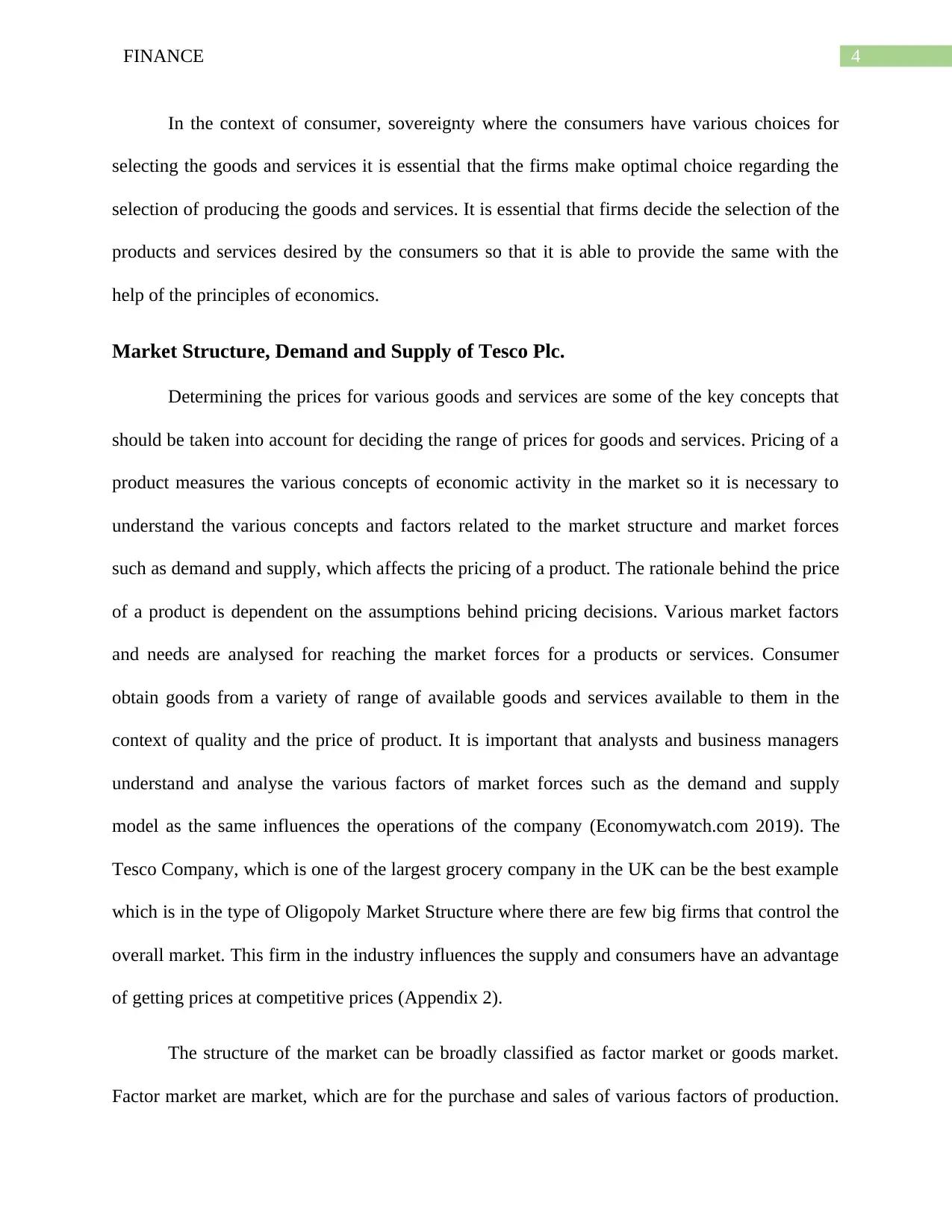
4FINANCE
In the context of consumer, sovereignty where the consumers have various choices for
selecting the goods and services it is essential that the firms make optimal choice regarding the
selection of producing the goods and services. It is essential that firms decide the selection of the
products and services desired by the consumers so that it is able to provide the same with the
help of the principles of economics.
Market Structure, Demand and Supply of Tesco Plc.
Determining the prices for various goods and services are some of the key concepts that
should be taken into account for deciding the range of prices for goods and services. Pricing of a
product measures the various concepts of economic activity in the market so it is necessary to
understand the various concepts and factors related to the market structure and market forces
such as demand and supply, which affects the pricing of a product. The rationale behind the price
of a product is dependent on the assumptions behind pricing decisions. Various market factors
and needs are analysed for reaching the market forces for a products or services. Consumer
obtain goods from a variety of range of available goods and services available to them in the
context of quality and the price of product. It is important that analysts and business managers
understand and analyse the various factors of market forces such as the demand and supply
model as the same influences the operations of the company (Economywatch.com 2019). The
Tesco Company, which is one of the largest grocery company in the UK can be the best example
which is in the type of Oligopoly Market Structure where there are few big firms that control the
overall market. This firm in the industry influences the supply and consumers have an advantage
of getting prices at competitive prices (Appendix 2).
The structure of the market can be broadly classified as factor market or goods market.
Factor market are market, which are for the purchase and sales of various factors of production.
In the context of consumer, sovereignty where the consumers have various choices for
selecting the goods and services it is essential that the firms make optimal choice regarding the
selection of producing the goods and services. It is essential that firms decide the selection of the
products and services desired by the consumers so that it is able to provide the same with the
help of the principles of economics.
Market Structure, Demand and Supply of Tesco Plc.
Determining the prices for various goods and services are some of the key concepts that
should be taken into account for deciding the range of prices for goods and services. Pricing of a
product measures the various concepts of economic activity in the market so it is necessary to
understand the various concepts and factors related to the market structure and market forces
such as demand and supply, which affects the pricing of a product. The rationale behind the price
of a product is dependent on the assumptions behind pricing decisions. Various market factors
and needs are analysed for reaching the market forces for a products or services. Consumer
obtain goods from a variety of range of available goods and services available to them in the
context of quality and the price of product. It is important that analysts and business managers
understand and analyse the various factors of market forces such as the demand and supply
model as the same influences the operations of the company (Economywatch.com 2019). The
Tesco Company, which is one of the largest grocery company in the UK can be the best example
which is in the type of Oligopoly Market Structure where there are few big firms that control the
overall market. This firm in the industry influences the supply and consumers have an advantage
of getting prices at competitive prices (Appendix 2).
The structure of the market can be broadly classified as factor market or goods market.
Factor market are market, which are for the purchase and sales of various factors of production.
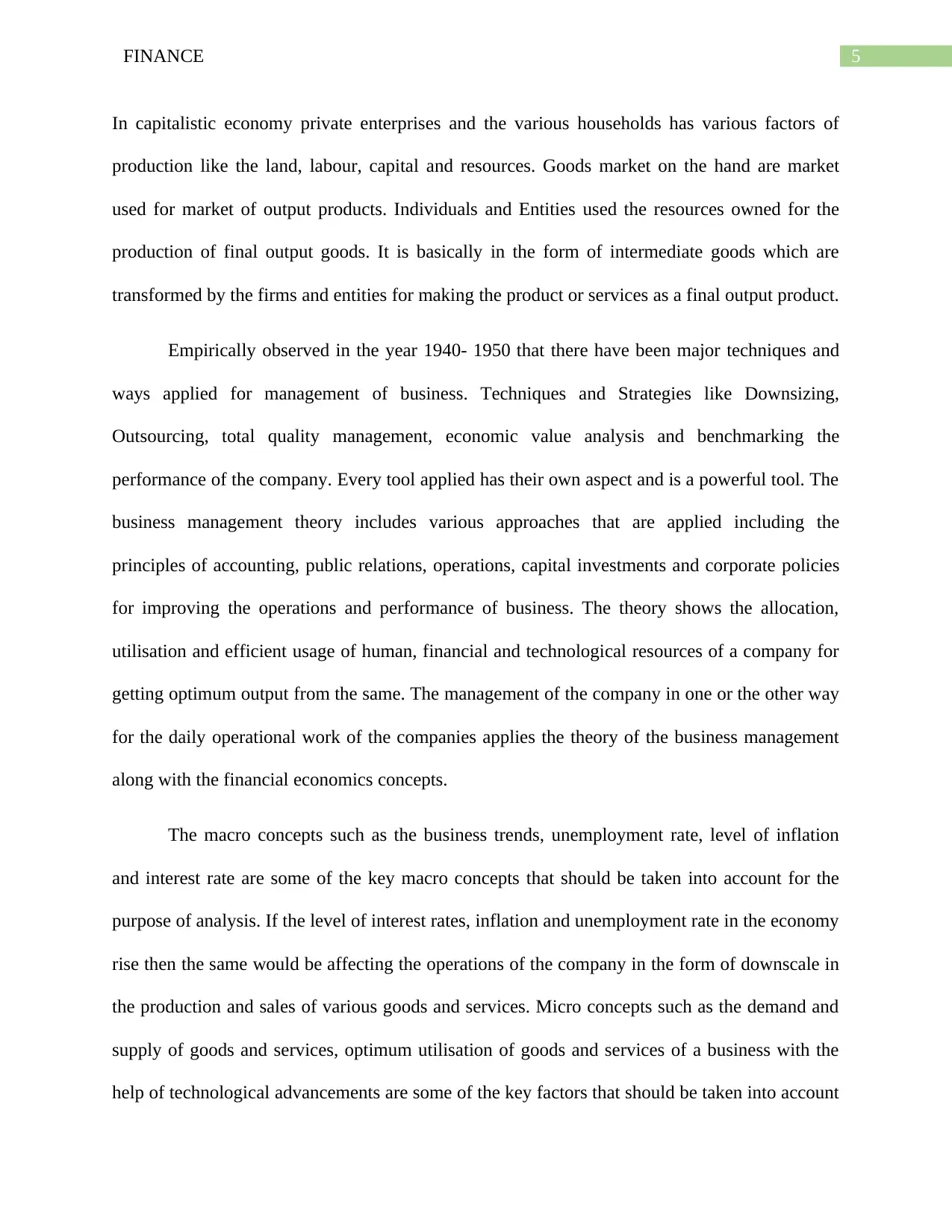
5FINANCE
In capitalistic economy private enterprises and the various households has various factors of
production like the land, labour, capital and resources. Goods market on the hand are market
used for market of output products. Individuals and Entities used the resources owned for the
production of final output goods. It is basically in the form of intermediate goods which are
transformed by the firms and entities for making the product or services as a final output product.
Empirically observed in the year 1940- 1950 that there have been major techniques and
ways applied for management of business. Techniques and Strategies like Downsizing,
Outsourcing, total quality management, economic value analysis and benchmarking the
performance of the company. Every tool applied has their own aspect and is a powerful tool. The
business management theory includes various approaches that are applied including the
principles of accounting, public relations, operations, capital investments and corporate policies
for improving the operations and performance of business. The theory shows the allocation,
utilisation and efficient usage of human, financial and technological resources of a company for
getting optimum output from the same. The management of the company in one or the other way
for the daily operational work of the companies applies the theory of the business management
along with the financial economics concepts.
The macro concepts such as the business trends, unemployment rate, level of inflation
and interest rate are some of the key macro concepts that should be taken into account for the
purpose of analysis. If the level of interest rates, inflation and unemployment rate in the economy
rise then the same would be affecting the operations of the company in the form of downscale in
the production and sales of various goods and services. Micro concepts such as the demand and
supply of goods and services, optimum utilisation of goods and services of a business with the
help of technological advancements are some of the key factors that should be taken into account
In capitalistic economy private enterprises and the various households has various factors of
production like the land, labour, capital and resources. Goods market on the hand are market
used for market of output products. Individuals and Entities used the resources owned for the
production of final output goods. It is basically in the form of intermediate goods which are
transformed by the firms and entities for making the product or services as a final output product.
Empirically observed in the year 1940- 1950 that there have been major techniques and
ways applied for management of business. Techniques and Strategies like Downsizing,
Outsourcing, total quality management, economic value analysis and benchmarking the
performance of the company. Every tool applied has their own aspect and is a powerful tool. The
business management theory includes various approaches that are applied including the
principles of accounting, public relations, operations, capital investments and corporate policies
for improving the operations and performance of business. The theory shows the allocation,
utilisation and efficient usage of human, financial and technological resources of a company for
getting optimum output from the same. The management of the company in one or the other way
for the daily operational work of the companies applies the theory of the business management
along with the financial economics concepts.
The macro concepts such as the business trends, unemployment rate, level of inflation
and interest rate are some of the key macro concepts that should be taken into account for the
purpose of analysis. If the level of interest rates, inflation and unemployment rate in the economy
rise then the same would be affecting the operations of the company in the form of downscale in
the production and sales of various goods and services. Micro concepts such as the demand and
supply of goods and services, optimum utilisation of goods and services of a business with the
help of technological advancements are some of the key factors that should be taken into account
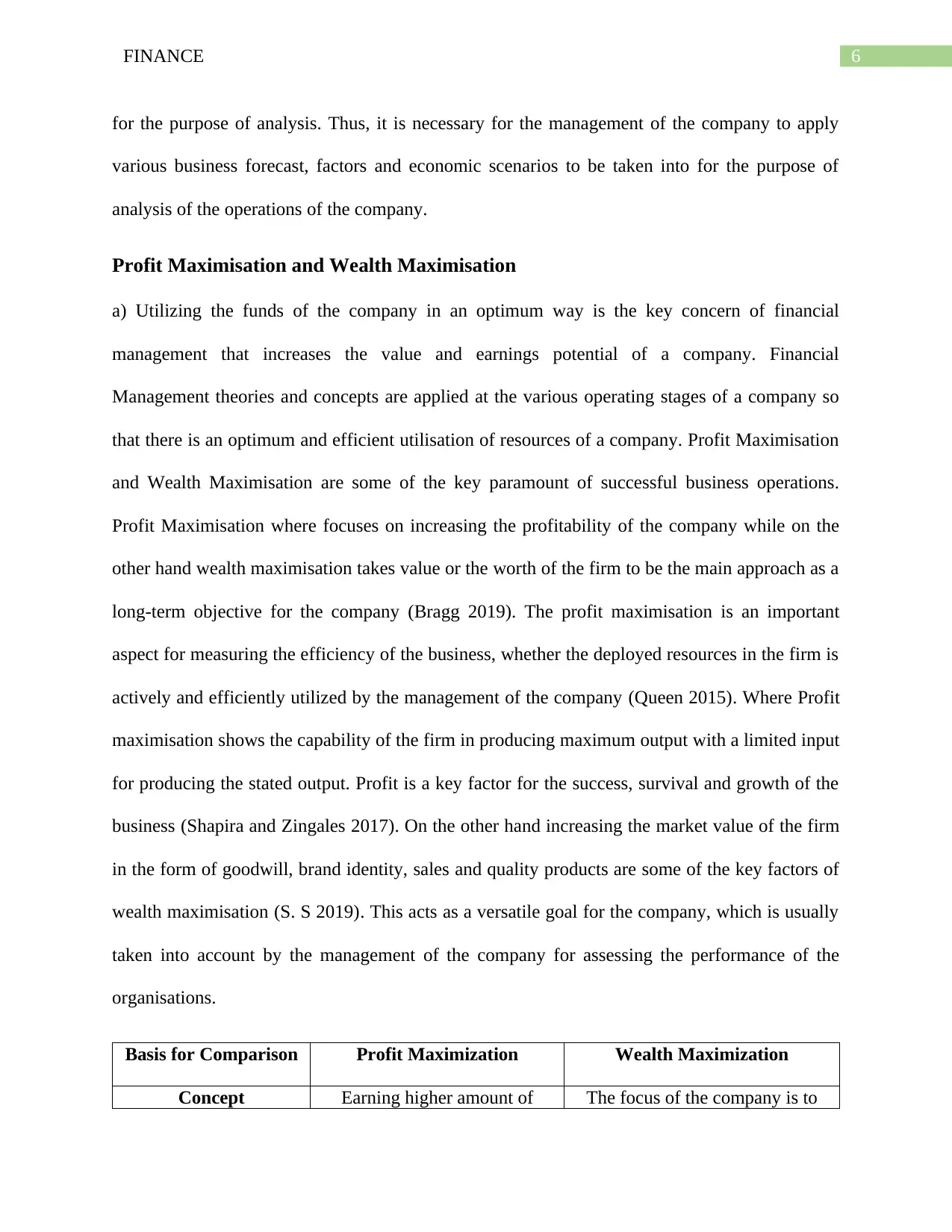
6FINANCE
for the purpose of analysis. Thus, it is necessary for the management of the company to apply
various business forecast, factors and economic scenarios to be taken into for the purpose of
analysis of the operations of the company.
Profit Maximisation and Wealth Maximisation
a) Utilizing the funds of the company in an optimum way is the key concern of financial
management that increases the value and earnings potential of a company. Financial
Management theories and concepts are applied at the various operating stages of a company so
that there is an optimum and efficient utilisation of resources of a company. Profit Maximisation
and Wealth Maximisation are some of the key paramount of successful business operations.
Profit Maximisation where focuses on increasing the profitability of the company while on the
other hand wealth maximisation takes value or the worth of the firm to be the main approach as a
long-term objective for the company (Bragg 2019). The profit maximisation is an important
aspect for measuring the efficiency of the business, whether the deployed resources in the firm is
actively and efficiently utilized by the management of the company (Queen 2015). Where Profit
maximisation shows the capability of the firm in producing maximum output with a limited input
for producing the stated output. Profit is a key factor for the success, survival and growth of the
business (Shapira and Zingales 2017). On the other hand increasing the market value of the firm
in the form of goodwill, brand identity, sales and quality products are some of the key factors of
wealth maximisation (S. S 2019). This acts as a versatile goal for the company, which is usually
taken into account by the management of the company for assessing the performance of the
organisations.
Basis for Comparison Profit Maximization Wealth Maximization
Concept Earning higher amount of The focus of the company is to
for the purpose of analysis. Thus, it is necessary for the management of the company to apply
various business forecast, factors and economic scenarios to be taken into for the purpose of
analysis of the operations of the company.
Profit Maximisation and Wealth Maximisation
a) Utilizing the funds of the company in an optimum way is the key concern of financial
management that increases the value and earnings potential of a company. Financial
Management theories and concepts are applied at the various operating stages of a company so
that there is an optimum and efficient utilisation of resources of a company. Profit Maximisation
and Wealth Maximisation are some of the key paramount of successful business operations.
Profit Maximisation where focuses on increasing the profitability of the company while on the
other hand wealth maximisation takes value or the worth of the firm to be the main approach as a
long-term objective for the company (Bragg 2019). The profit maximisation is an important
aspect for measuring the efficiency of the business, whether the deployed resources in the firm is
actively and efficiently utilized by the management of the company (Queen 2015). Where Profit
maximisation shows the capability of the firm in producing maximum output with a limited input
for producing the stated output. Profit is a key factor for the success, survival and growth of the
business (Shapira and Zingales 2017). On the other hand increasing the market value of the firm
in the form of goodwill, brand identity, sales and quality products are some of the key factors of
wealth maximisation (S. S 2019). This acts as a versatile goal for the company, which is usually
taken into account by the management of the company for assessing the performance of the
organisations.
Basis for Comparison Profit Maximization Wealth Maximization
Concept Earning higher amount of The focus of the company is to
Paraphrase This Document
Need a fresh take? Get an instant paraphrase of this document with our AI Paraphraser
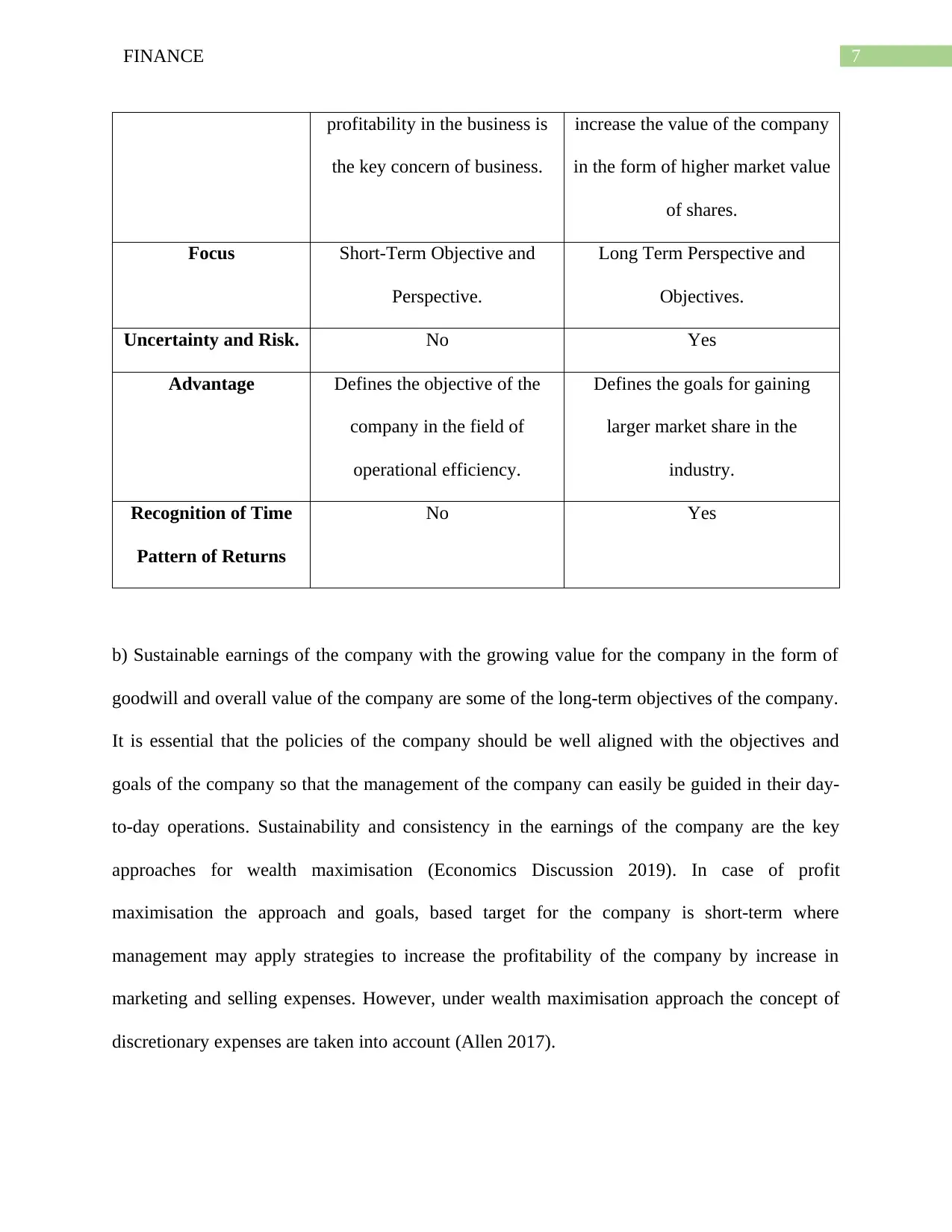
7FINANCE
profitability in the business is
the key concern of business.
increase the value of the company
in the form of higher market value
of shares.
Focus Short-Term Objective and
Perspective.
Long Term Perspective and
Objectives.
Uncertainty and Risk. No Yes
Advantage Defines the objective of the
company in the field of
operational efficiency.
Defines the goals for gaining
larger market share in the
industry.
Recognition of Time
Pattern of Returns
No Yes
b) Sustainable earnings of the company with the growing value for the company in the form of
goodwill and overall value of the company are some of the long-term objectives of the company.
It is essential that the policies of the company should be well aligned with the objectives and
goals of the company so that the management of the company can easily be guided in their day-
to-day operations. Sustainability and consistency in the earnings of the company are the key
approaches for wealth maximisation (Economics Discussion 2019). In case of profit
maximisation the approach and goals, based target for the company is short-term where
management may apply strategies to increase the profitability of the company by increase in
marketing and selling expenses. However, under wealth maximisation approach the concept of
discretionary expenses are taken into account (Allen 2017).
profitability in the business is
the key concern of business.
increase the value of the company
in the form of higher market value
of shares.
Focus Short-Term Objective and
Perspective.
Long Term Perspective and
Objectives.
Uncertainty and Risk. No Yes
Advantage Defines the objective of the
company in the field of
operational efficiency.
Defines the goals for gaining
larger market share in the
industry.
Recognition of Time
Pattern of Returns
No Yes
b) Sustainable earnings of the company with the growing value for the company in the form of
goodwill and overall value of the company are some of the long-term objectives of the company.
It is essential that the policies of the company should be well aligned with the objectives and
goals of the company so that the management of the company can easily be guided in their day-
to-day operations. Sustainability and consistency in the earnings of the company are the key
approaches for wealth maximisation (Economics Discussion 2019). In case of profit
maximisation the approach and goals, based target for the company is short-term where
management may apply strategies to increase the profitability of the company by increase in
marketing and selling expenses. However, under wealth maximisation approach the concept of
discretionary expenses are taken into account (Allen 2017).
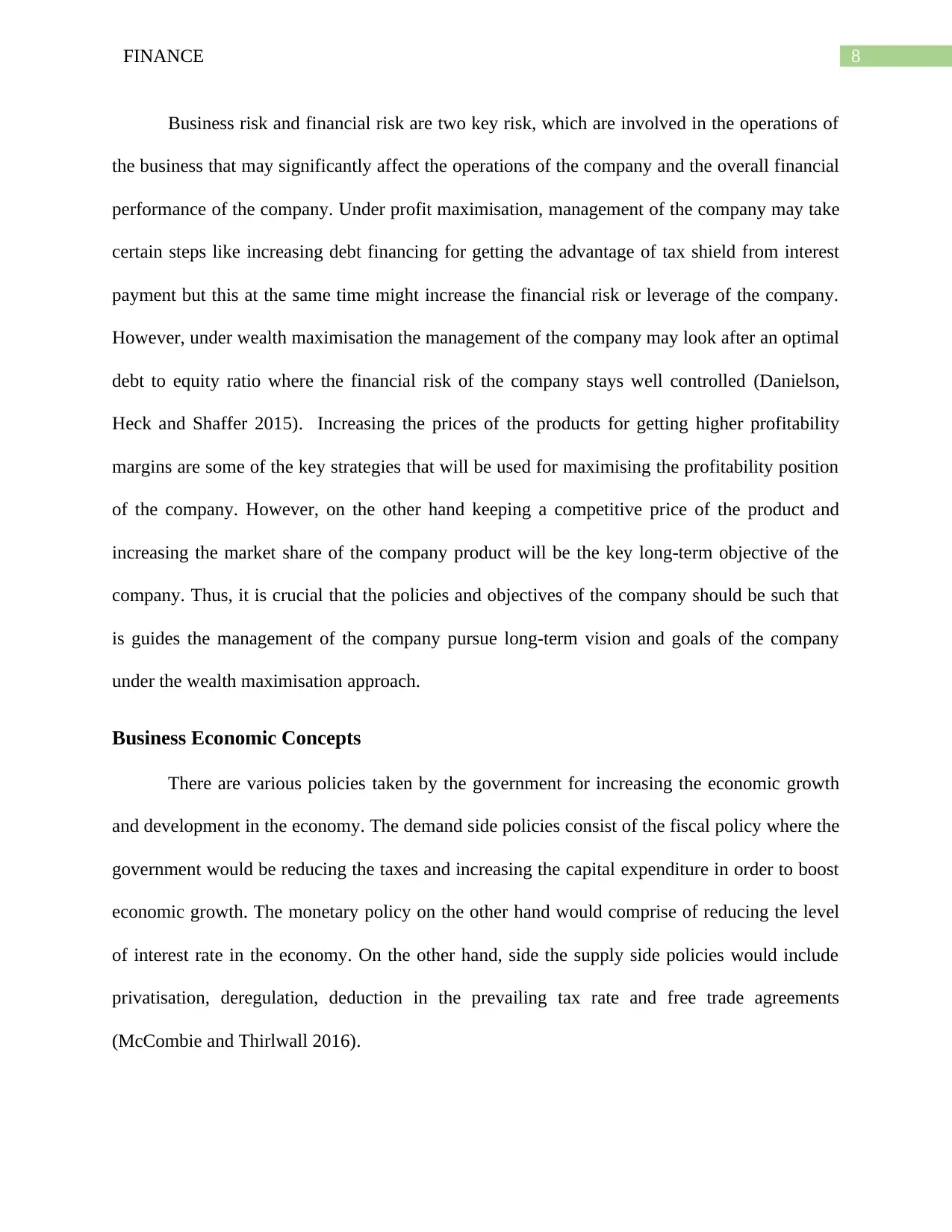
8FINANCE
Business risk and financial risk are two key risk, which are involved in the operations of
the business that may significantly affect the operations of the company and the overall financial
performance of the company. Under profit maximisation, management of the company may take
certain steps like increasing debt financing for getting the advantage of tax shield from interest
payment but this at the same time might increase the financial risk or leverage of the company.
However, under wealth maximisation the management of the company may look after an optimal
debt to equity ratio where the financial risk of the company stays well controlled (Danielson,
Heck and Shaffer 2015). Increasing the prices of the products for getting higher profitability
margins are some of the key strategies that will be used for maximising the profitability position
of the company. However, on the other hand keeping a competitive price of the product and
increasing the market share of the company product will be the key long-term objective of the
company. Thus, it is crucial that the policies and objectives of the company should be such that
is guides the management of the company pursue long-term vision and goals of the company
under the wealth maximisation approach.
Business Economic Concepts
There are various policies taken by the government for increasing the economic growth
and development in the economy. The demand side policies consist of the fiscal policy where the
government would be reducing the taxes and increasing the capital expenditure in order to boost
economic growth. The monetary policy on the other hand would comprise of reducing the level
of interest rate in the economy. On the other hand, side the supply side policies would include
privatisation, deregulation, deduction in the prevailing tax rate and free trade agreements
(McCombie and Thirlwall 2016).
Business risk and financial risk are two key risk, which are involved in the operations of
the business that may significantly affect the operations of the company and the overall financial
performance of the company. Under profit maximisation, management of the company may take
certain steps like increasing debt financing for getting the advantage of tax shield from interest
payment but this at the same time might increase the financial risk or leverage of the company.
However, under wealth maximisation the management of the company may look after an optimal
debt to equity ratio where the financial risk of the company stays well controlled (Danielson,
Heck and Shaffer 2015). Increasing the prices of the products for getting higher profitability
margins are some of the key strategies that will be used for maximising the profitability position
of the company. However, on the other hand keeping a competitive price of the product and
increasing the market share of the company product will be the key long-term objective of the
company. Thus, it is crucial that the policies and objectives of the company should be such that
is guides the management of the company pursue long-term vision and goals of the company
under the wealth maximisation approach.
Business Economic Concepts
There are various policies taken by the government for increasing the economic growth
and development in the economy. The demand side policies consist of the fiscal policy where the
government would be reducing the taxes and increasing the capital expenditure in order to boost
economic growth. The monetary policy on the other hand would comprise of reducing the level
of interest rate in the economy. On the other hand, side the supply side policies would include
privatisation, deregulation, deduction in the prevailing tax rate and free trade agreements
(McCombie and Thirlwall 2016).
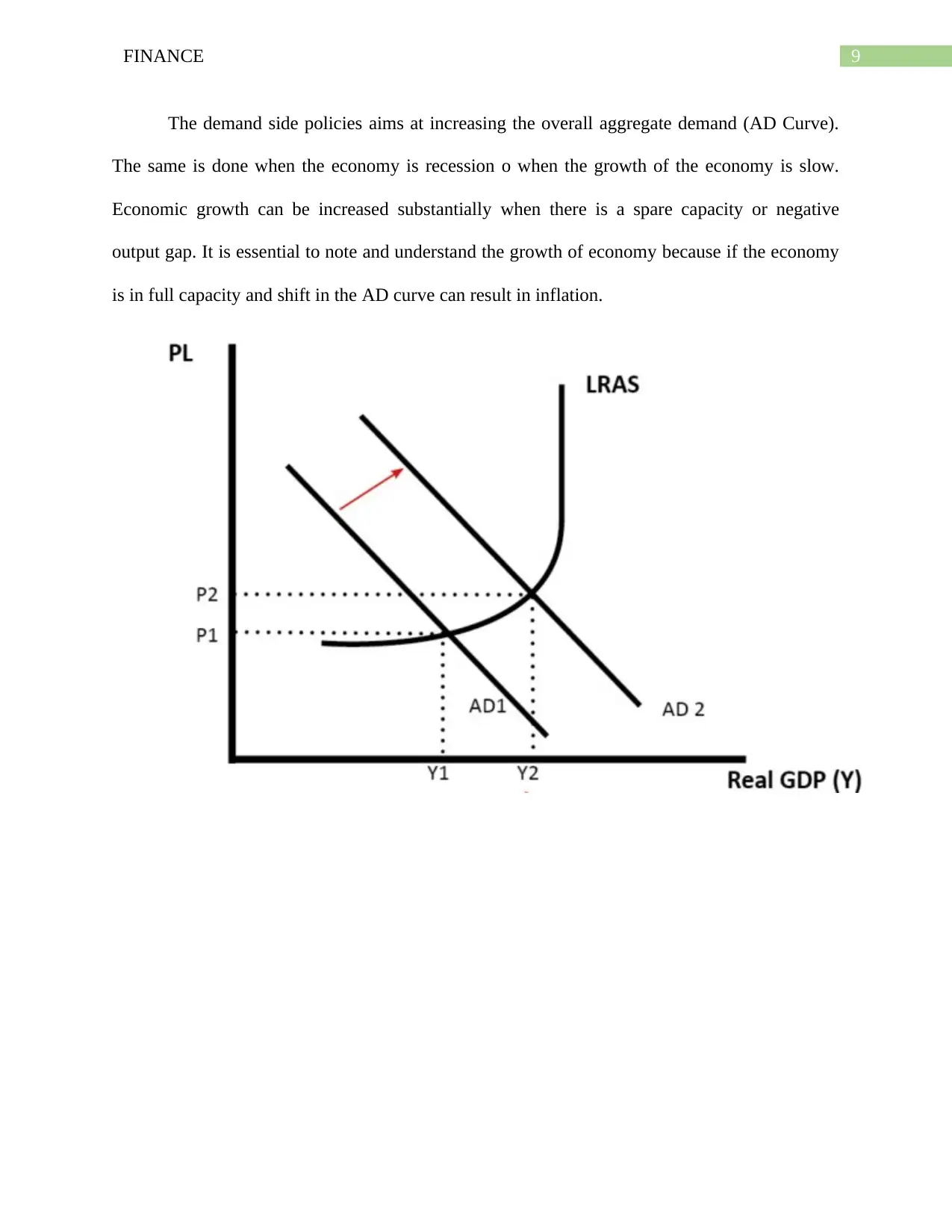
9FINANCE
The demand side policies aims at increasing the overall aggregate demand (AD Curve).
The same is done when the economy is recession o when the growth of the economy is slow.
Economic growth can be increased substantially when there is a spare capacity or negative
output gap. It is essential to note and understand the growth of economy because if the economy
is in full capacity and shift in the AD curve can result in inflation.
The demand side policies aims at increasing the overall aggregate demand (AD Curve).
The same is done when the economy is recession o when the growth of the economy is slow.
Economic growth can be increased substantially when there is a spare capacity or negative
output gap. It is essential to note and understand the growth of economy because if the economy
is in full capacity and shift in the AD curve can result in inflation.
Secure Best Marks with AI Grader
Need help grading? Try our AI Grader for instant feedback on your assignments.
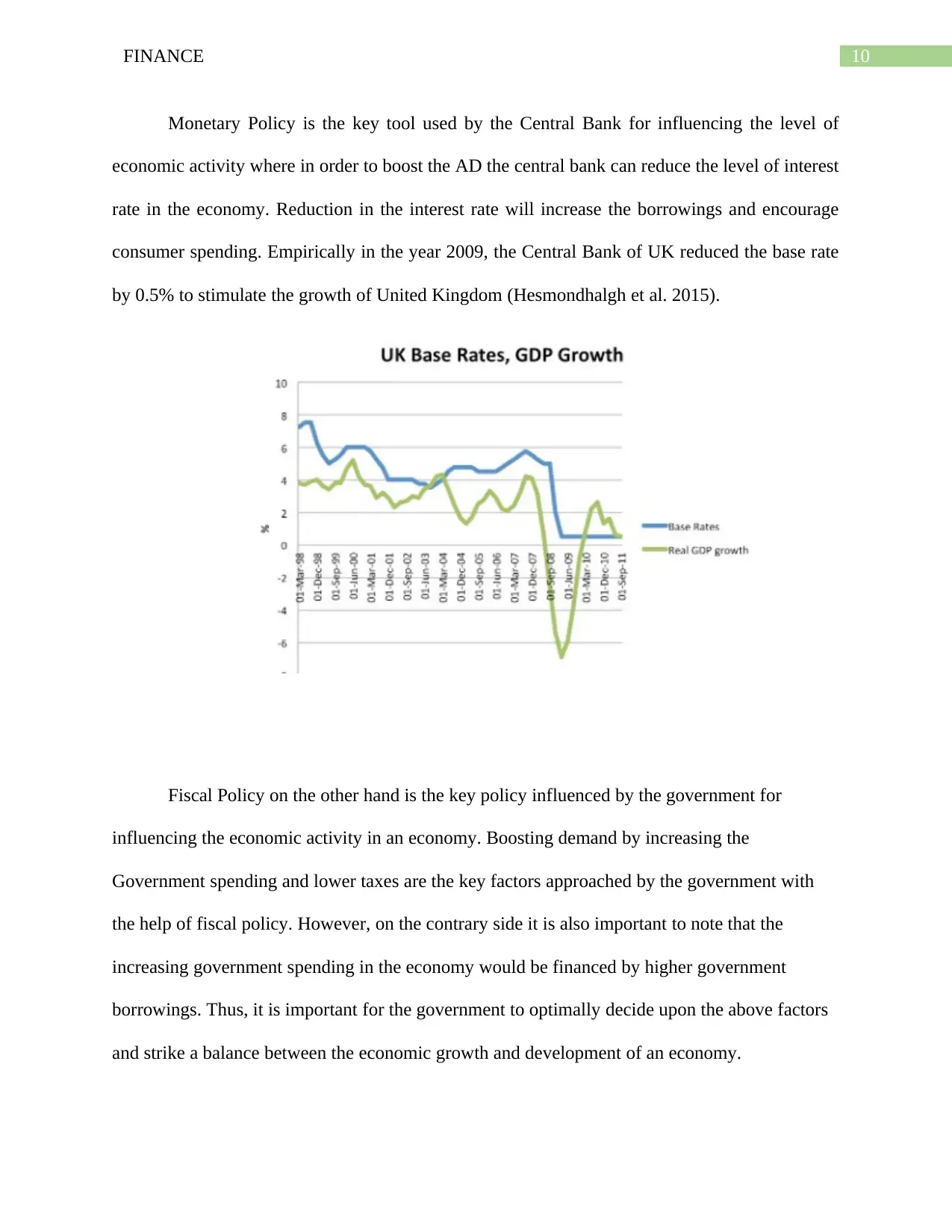
10FINANCE
Monetary Policy is the key tool used by the Central Bank for influencing the level of
economic activity where in order to boost the AD the central bank can reduce the level of interest
rate in the economy. Reduction in the interest rate will increase the borrowings and encourage
consumer spending. Empirically in the year 2009, the Central Bank of UK reduced the base rate
by 0.5% to stimulate the growth of United Kingdom (Hesmondhalgh et al. 2015).
Fiscal Policy on the other hand is the key policy influenced by the government for
influencing the economic activity in an economy. Boosting demand by increasing the
Government spending and lower taxes are the key factors approached by the government with
the help of fiscal policy. However, on the contrary side it is also important to note that the
increasing government spending in the economy would be financed by higher government
borrowings. Thus, it is important for the government to optimally decide upon the above factors
and strike a balance between the economic growth and development of an economy.
Monetary Policy is the key tool used by the Central Bank for influencing the level of
economic activity where in order to boost the AD the central bank can reduce the level of interest
rate in the economy. Reduction in the interest rate will increase the borrowings and encourage
consumer spending. Empirically in the year 2009, the Central Bank of UK reduced the base rate
by 0.5% to stimulate the growth of United Kingdom (Hesmondhalgh et al. 2015).
Fiscal Policy on the other hand is the key policy influenced by the government for
influencing the economic activity in an economy. Boosting demand by increasing the
Government spending and lower taxes are the key factors approached by the government with
the help of fiscal policy. However, on the contrary side it is also important to note that the
increasing government spending in the economy would be financed by higher government
borrowings. Thus, it is important for the government to optimally decide upon the above factors
and strike a balance between the economic growth and development of an economy.
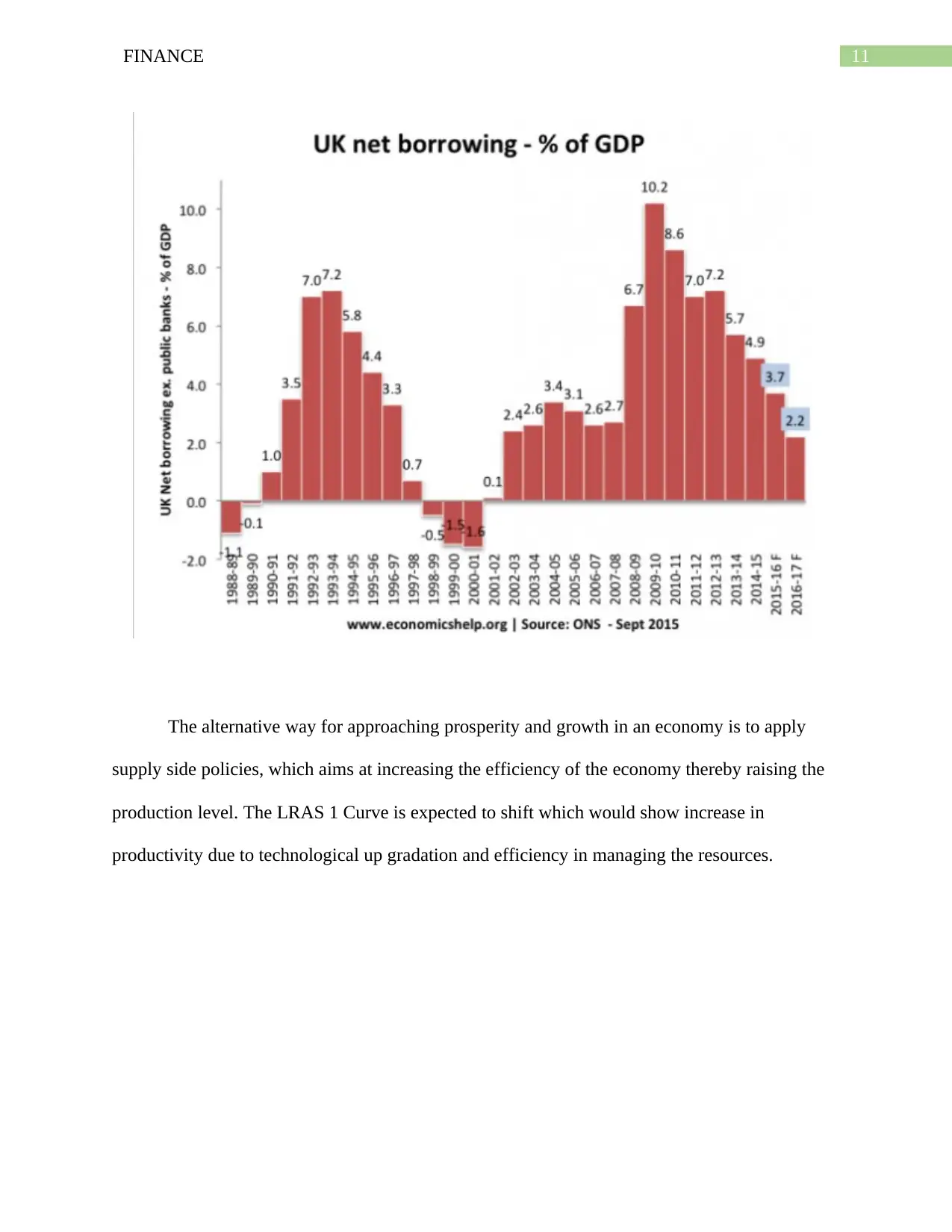
11FINANCE
The alternative way for approaching prosperity and growth in an economy is to apply
supply side policies, which aims at increasing the efficiency of the economy thereby raising the
production level. The LRAS 1 Curve is expected to shift which would show increase in
productivity due to technological up gradation and efficiency in managing the resources.
The alternative way for approaching prosperity and growth in an economy is to apply
supply side policies, which aims at increasing the efficiency of the economy thereby raising the
production level. The LRAS 1 Curve is expected to shift which would show increase in
productivity due to technological up gradation and efficiency in managing the resources.
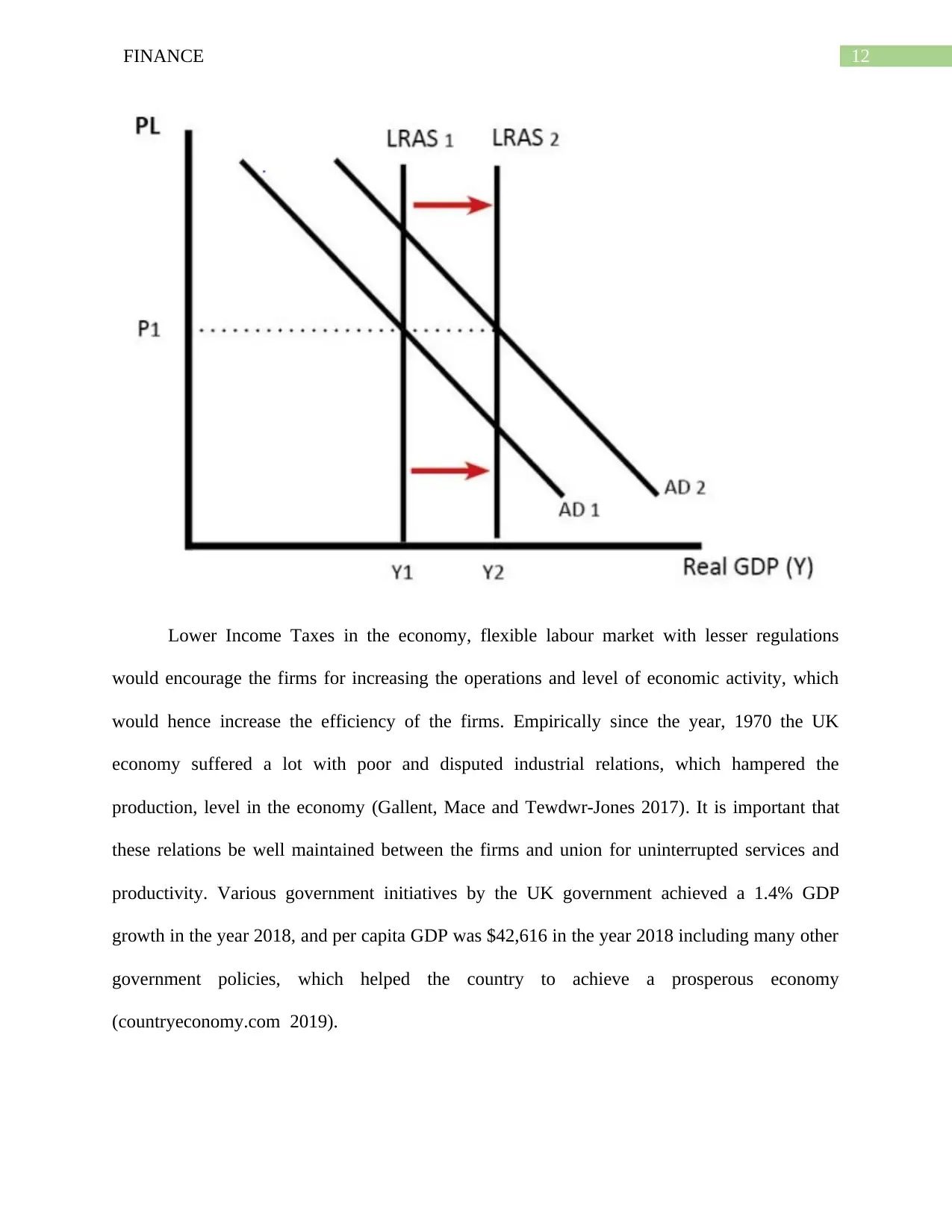
12FINANCE
Lower Income Taxes in the economy, flexible labour market with lesser regulations
would encourage the firms for increasing the operations and level of economic activity, which
would hence increase the efficiency of the firms. Empirically since the year, 1970 the UK
economy suffered a lot with poor and disputed industrial relations, which hampered the
production, level in the economy (Gallent, Mace and Tewdwr-Jones 2017). It is important that
these relations be well maintained between the firms and union for uninterrupted services and
productivity. Various government initiatives by the UK government achieved a 1.4% GDP
growth in the year 2018, and per capita GDP was $42,616 in the year 2018 including many other
government policies, which helped the country to achieve a prosperous economy
(countryeconomy.com 2019).
Lower Income Taxes in the economy, flexible labour market with lesser regulations
would encourage the firms for increasing the operations and level of economic activity, which
would hence increase the efficiency of the firms. Empirically since the year, 1970 the UK
economy suffered a lot with poor and disputed industrial relations, which hampered the
production, level in the economy (Gallent, Mace and Tewdwr-Jones 2017). It is important that
these relations be well maintained between the firms and union for uninterrupted services and
productivity. Various government initiatives by the UK government achieved a 1.4% GDP
growth in the year 2018, and per capita GDP was $42,616 in the year 2018 including many other
government policies, which helped the country to achieve a prosperous economy
(countryeconomy.com 2019).
Paraphrase This Document
Need a fresh take? Get an instant paraphrase of this document with our AI Paraphraser
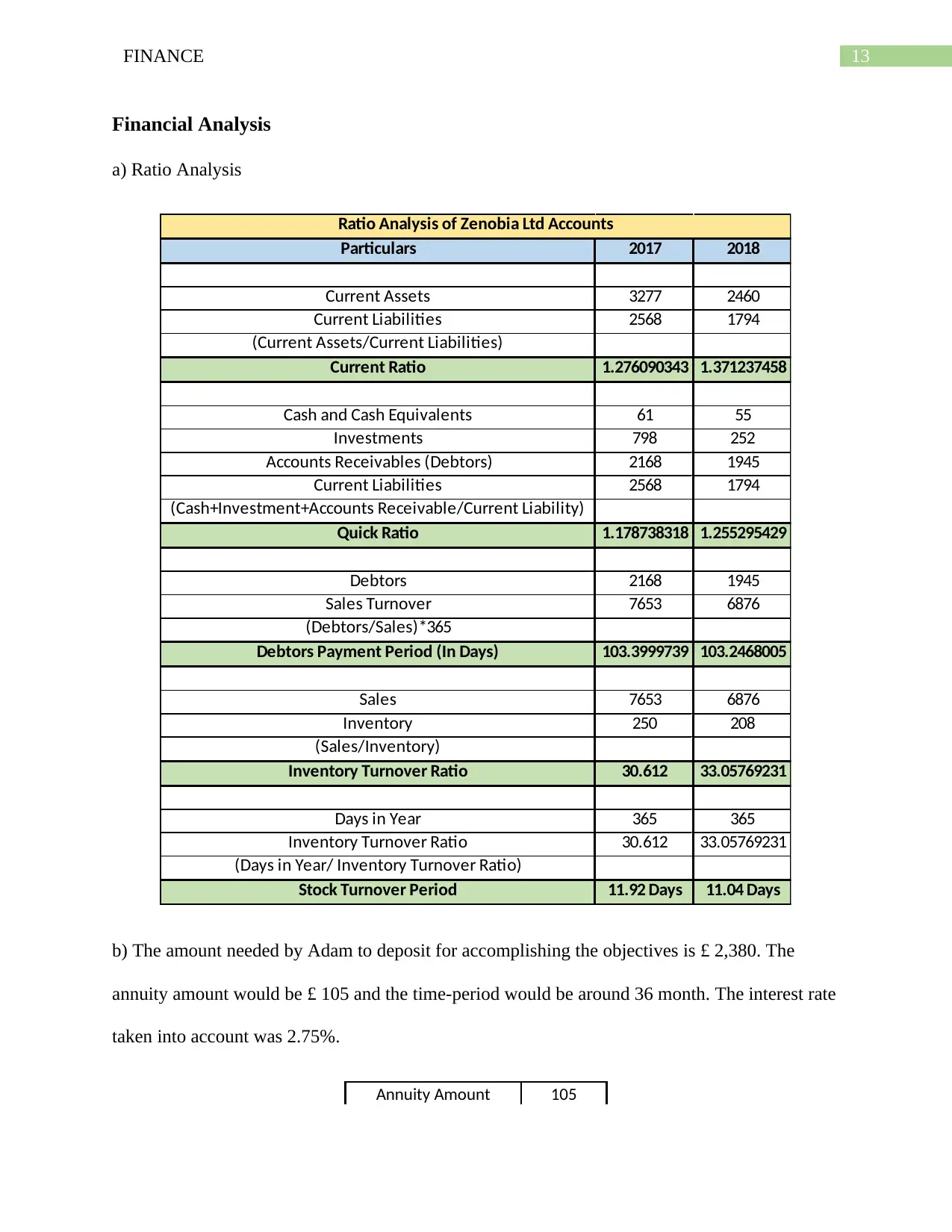
13FINANCE
Financial Analysis
a) Ratio Analysis
Particulars 2017 2018
Current Assets 3277 2460
Current Liabilities 2568 1794
(Current Assets/Current Liabilities)
Current Ratio 1.276090343 1.371237458
Cash and Cash Equivalents 61 55
Investments 798 252
Accounts Receivables (Debtors) 2168 1945
Current Liabilities 2568 1794
(Cash+Investment+Accounts Receivable/Current Liability)
Quick Ratio 1.178738318 1.255295429
Debtors 2168 1945
Sales Turnover 7653 6876
(Debtors/Sales)*365
Debtors Payment Period (In Days) 103.3999739 103.2468005
Sales 7653 6876
Inventory 250 208
(Sales/Inventory)
Inventory Turnover Ratio 30.612 33.05769231
Days in Year 365 365
Inventory Turnover Ratio 30.612 33.05769231
(Days in Year/ Inventory Turnover Ratio)
Stock Turnover Period 11.92 Days 11.04 Days
Ratio Analysis of Zenobia Ltd Accounts
b) The amount needed by Adam to deposit for accomplishing the objectives is £ 2,380. The
annuity amount would be £ 105 and the time-period would be around 36 month. The interest rate
taken into account was 2.75%.
Annuity Amount 105
Financial Analysis
a) Ratio Analysis
Particulars 2017 2018
Current Assets 3277 2460
Current Liabilities 2568 1794
(Current Assets/Current Liabilities)
Current Ratio 1.276090343 1.371237458
Cash and Cash Equivalents 61 55
Investments 798 252
Accounts Receivables (Debtors) 2168 1945
Current Liabilities 2568 1794
(Cash+Investment+Accounts Receivable/Current Liability)
Quick Ratio 1.178738318 1.255295429
Debtors 2168 1945
Sales Turnover 7653 6876
(Debtors/Sales)*365
Debtors Payment Period (In Days) 103.3999739 103.2468005
Sales 7653 6876
Inventory 250 208
(Sales/Inventory)
Inventory Turnover Ratio 30.612 33.05769231
Days in Year 365 365
Inventory Turnover Ratio 30.612 33.05769231
(Days in Year/ Inventory Turnover Ratio)
Stock Turnover Period 11.92 Days 11.04 Days
Ratio Analysis of Zenobia Ltd Accounts
b) The amount needed by Adam to deposit for accomplishing the objectives is £ 2,380. The
annuity amount would be £ 105 and the time-period would be around 36 month. The interest rate
taken into account was 2.75%.
Annuity Amount 105
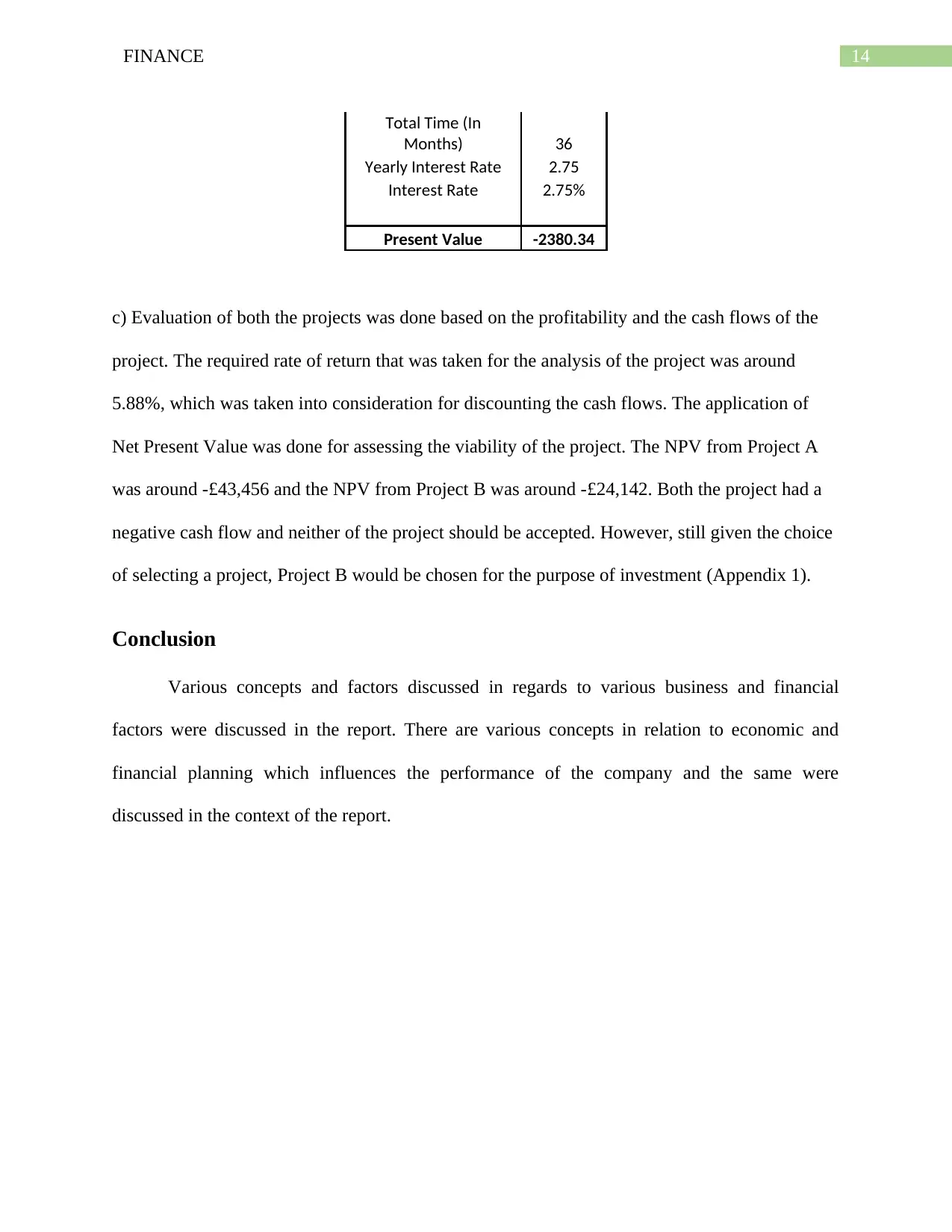
14FINANCE
Total Time (In
Months) 36
Yearly Interest Rate 2.75
Interest Rate 2.75%
Present Value -2380.34
c) Evaluation of both the projects was done based on the profitability and the cash flows of the
project. The required rate of return that was taken for the analysis of the project was around
5.88%, which was taken into consideration for discounting the cash flows. The application of
Net Present Value was done for assessing the viability of the project. The NPV from Project A
was around -£43,456 and the NPV from Project B was around -£24,142. Both the project had a
negative cash flow and neither of the project should be accepted. However, still given the choice
of selecting a project, Project B would be chosen for the purpose of investment (Appendix 1).
Conclusion
Various concepts and factors discussed in regards to various business and financial
factors were discussed in the report. There are various concepts in relation to economic and
financial planning which influences the performance of the company and the same were
discussed in the context of the report.
Total Time (In
Months) 36
Yearly Interest Rate 2.75
Interest Rate 2.75%
Present Value -2380.34
c) Evaluation of both the projects was done based on the profitability and the cash flows of the
project. The required rate of return that was taken for the analysis of the project was around
5.88%, which was taken into consideration for discounting the cash flows. The application of
Net Present Value was done for assessing the viability of the project. The NPV from Project A
was around -£43,456 and the NPV from Project B was around -£24,142. Both the project had a
negative cash flow and neither of the project should be accepted. However, still given the choice
of selecting a project, Project B would be chosen for the purpose of investment (Appendix 1).
Conclusion
Various concepts and factors discussed in regards to various business and financial
factors were discussed in the report. There are various concepts in relation to economic and
financial planning which influences the performance of the company and the same were
discussed in the context of the report.
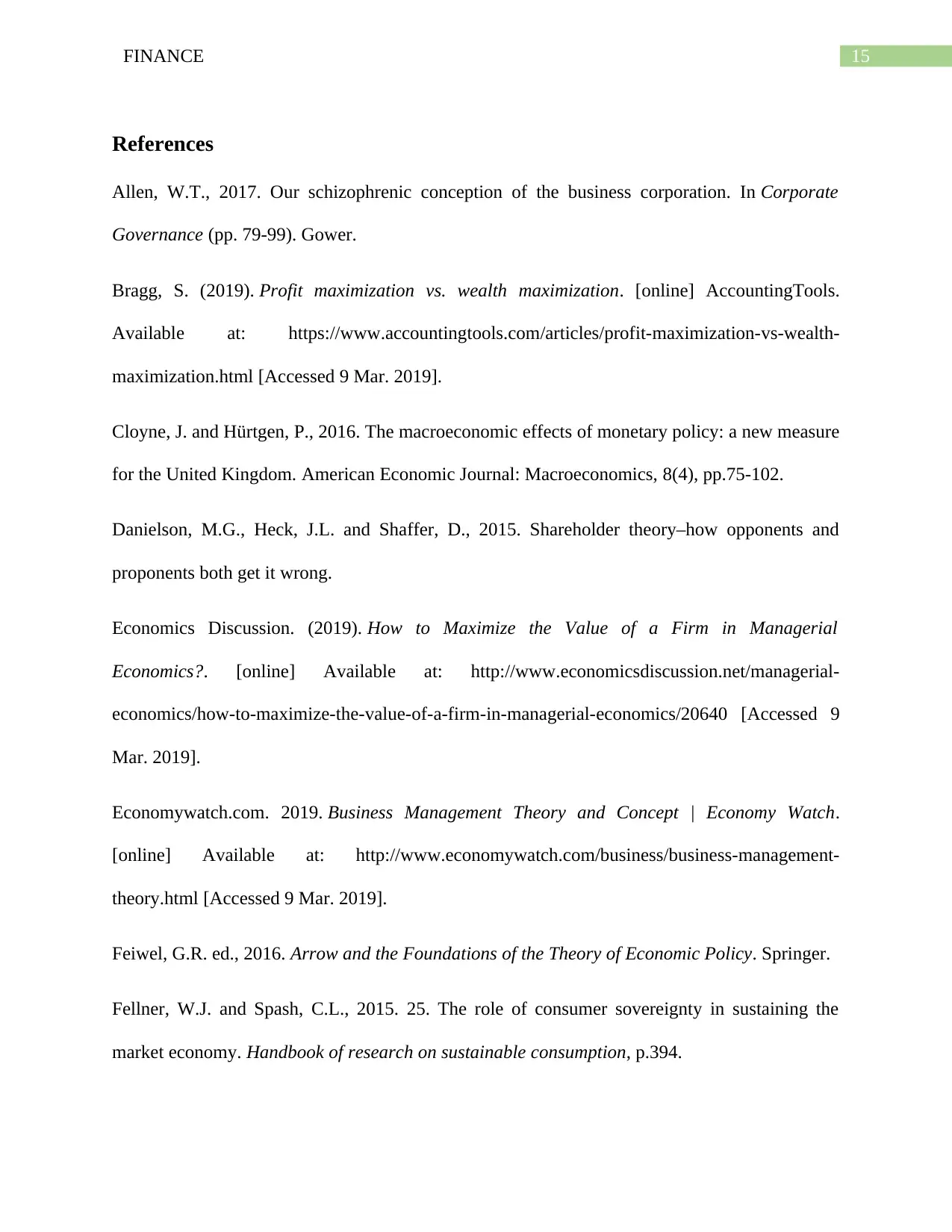
15FINANCE
References
Allen, W.T., 2017. Our schizophrenic conception of the business corporation. In Corporate
Governance (pp. 79-99). Gower.
Bragg, S. (2019). Profit maximization vs. wealth maximization. [online] AccountingTools.
Available at: https://www.accountingtools.com/articles/profit-maximization-vs-wealth-
maximization.html [Accessed 9 Mar. 2019].
Cloyne, J. and Hürtgen, P., 2016. The macroeconomic effects of monetary policy: a new measure
for the United Kingdom. American Economic Journal: Macroeconomics, 8(4), pp.75-102.
Danielson, M.G., Heck, J.L. and Shaffer, D., 2015. Shareholder theory–how opponents and
proponents both get it wrong.
Economics Discussion. (2019). How to Maximize the Value of a Firm in Managerial
Economics?. [online] Available at: http://www.economicsdiscussion.net/managerial-
economics/how-to-maximize-the-value-of-a-firm-in-managerial-economics/20640 [Accessed 9
Mar. 2019].
Economywatch.com. 2019. Business Management Theory and Concept | Economy Watch.
[online] Available at: http://www.economywatch.com/business/business-management-
theory.html [Accessed 9 Mar. 2019].
Feiwel, G.R. ed., 2016. Arrow and the Foundations of the Theory of Economic Policy. Springer.
Fellner, W.J. and Spash, C.L., 2015. 25. The role of consumer sovereignty in sustaining the
market economy. Handbook of research on sustainable consumption, p.394.
References
Allen, W.T., 2017. Our schizophrenic conception of the business corporation. In Corporate
Governance (pp. 79-99). Gower.
Bragg, S. (2019). Profit maximization vs. wealth maximization. [online] AccountingTools.
Available at: https://www.accountingtools.com/articles/profit-maximization-vs-wealth-
maximization.html [Accessed 9 Mar. 2019].
Cloyne, J. and Hürtgen, P., 2016. The macroeconomic effects of monetary policy: a new measure
for the United Kingdom. American Economic Journal: Macroeconomics, 8(4), pp.75-102.
Danielson, M.G., Heck, J.L. and Shaffer, D., 2015. Shareholder theory–how opponents and
proponents both get it wrong.
Economics Discussion. (2019). How to Maximize the Value of a Firm in Managerial
Economics?. [online] Available at: http://www.economicsdiscussion.net/managerial-
economics/how-to-maximize-the-value-of-a-firm-in-managerial-economics/20640 [Accessed 9
Mar. 2019].
Economywatch.com. 2019. Business Management Theory and Concept | Economy Watch.
[online] Available at: http://www.economywatch.com/business/business-management-
theory.html [Accessed 9 Mar. 2019].
Feiwel, G.R. ed., 2016. Arrow and the Foundations of the Theory of Economic Policy. Springer.
Fellner, W.J. and Spash, C.L., 2015. 25. The role of consumer sovereignty in sustaining the
market economy. Handbook of research on sustainable consumption, p.394.
Secure Best Marks with AI Grader
Need help grading? Try our AI Grader for instant feedback on your assignments.
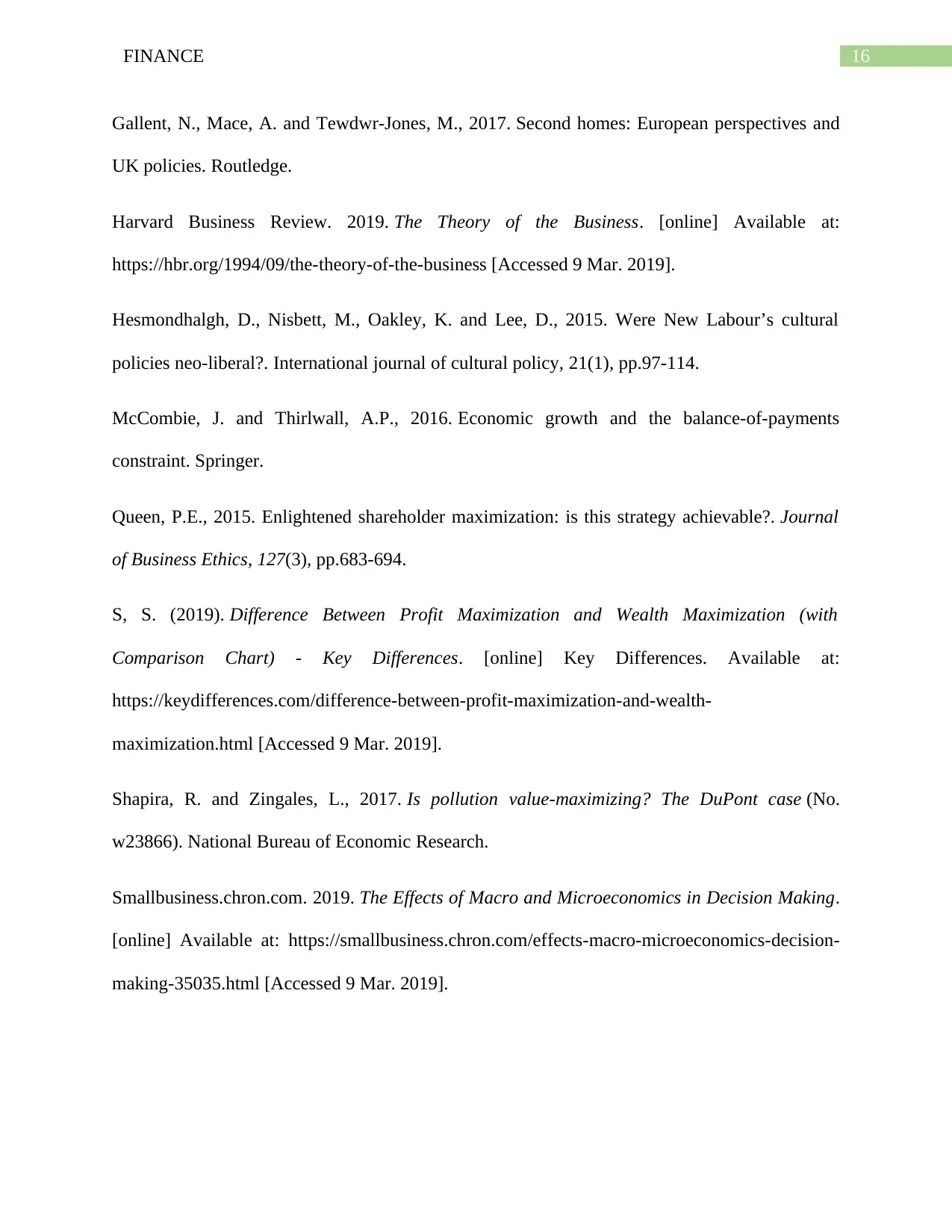
16FINANCE
Gallent, N., Mace, A. and Tewdwr-Jones, M., 2017. Second homes: European perspectives and
UK policies. Routledge.
Harvard Business Review. 2019. The Theory of the Business. [online] Available at:
https://hbr.org/1994/09/the-theory-of-the-business [Accessed 9 Mar. 2019].
Hesmondhalgh, D., Nisbett, M., Oakley, K. and Lee, D., 2015. Were New Labour’s cultural
policies neo-liberal?. International journal of cultural policy, 21(1), pp.97-114.
McCombie, J. and Thirlwall, A.P., 2016. Economic growth and the balance-of-payments
constraint. Springer.
Queen, P.E., 2015. Enlightened shareholder maximization: is this strategy achievable?. Journal
of Business Ethics, 127(3), pp.683-694.
S, S. (2019). Difference Between Profit Maximization and Wealth Maximization (with
Comparison Chart) - Key Differences. [online] Key Differences. Available at:
https://keydifferences.com/difference-between-profit-maximization-and-wealth-
maximization.html [Accessed 9 Mar. 2019].
Shapira, R. and Zingales, L., 2017. Is pollution value-maximizing? The DuPont case (No.
w23866). National Bureau of Economic Research.
Smallbusiness.chron.com. 2019. The Effects of Macro and Microeconomics in Decision Making.
[online] Available at: https://smallbusiness.chron.com/effects-macro-microeconomics-decision-
making-35035.html [Accessed 9 Mar. 2019].
Gallent, N., Mace, A. and Tewdwr-Jones, M., 2017. Second homes: European perspectives and
UK policies. Routledge.
Harvard Business Review. 2019. The Theory of the Business. [online] Available at:
https://hbr.org/1994/09/the-theory-of-the-business [Accessed 9 Mar. 2019].
Hesmondhalgh, D., Nisbett, M., Oakley, K. and Lee, D., 2015. Were New Labour’s cultural
policies neo-liberal?. International journal of cultural policy, 21(1), pp.97-114.
McCombie, J. and Thirlwall, A.P., 2016. Economic growth and the balance-of-payments
constraint. Springer.
Queen, P.E., 2015. Enlightened shareholder maximization: is this strategy achievable?. Journal
of Business Ethics, 127(3), pp.683-694.
S, S. (2019). Difference Between Profit Maximization and Wealth Maximization (with
Comparison Chart) - Key Differences. [online] Key Differences. Available at:
https://keydifferences.com/difference-between-profit-maximization-and-wealth-
maximization.html [Accessed 9 Mar. 2019].
Shapira, R. and Zingales, L., 2017. Is pollution value-maximizing? The DuPont case (No.
w23866). National Bureau of Economic Research.
Smallbusiness.chron.com. 2019. The Effects of Macro and Microeconomics in Decision Making.
[online] Available at: https://smallbusiness.chron.com/effects-macro-microeconomics-decision-
making-35035.html [Accessed 9 Mar. 2019].
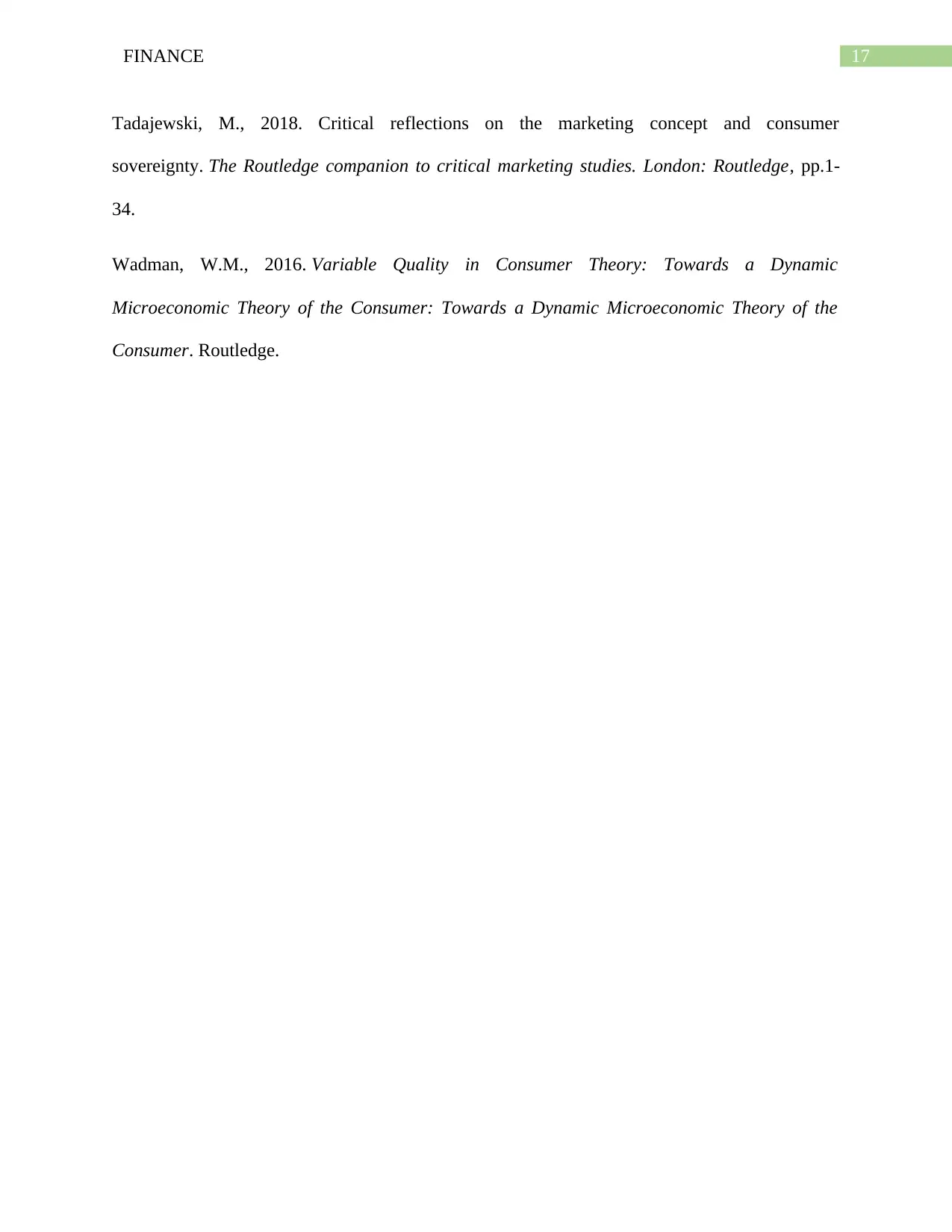
17FINANCE
Tadajewski, M., 2018. Critical reflections on the marketing concept and consumer
sovereignty. The Routledge companion to critical marketing studies. London: Routledge, pp.1-
34.
Wadman, W.M., 2016. Variable Quality in Consumer Theory: Towards a Dynamic
Microeconomic Theory of the Consumer: Towards a Dynamic Microeconomic Theory of the
Consumer. Routledge.
Tadajewski, M., 2018. Critical reflections on the marketing concept and consumer
sovereignty. The Routledge companion to critical marketing studies. London: Routledge, pp.1-
34.
Wadman, W.M., 2016. Variable Quality in Consumer Theory: Towards a Dynamic
Microeconomic Theory of the Consumer: Towards a Dynamic Microeconomic Theory of the
Consumer. Routledge.
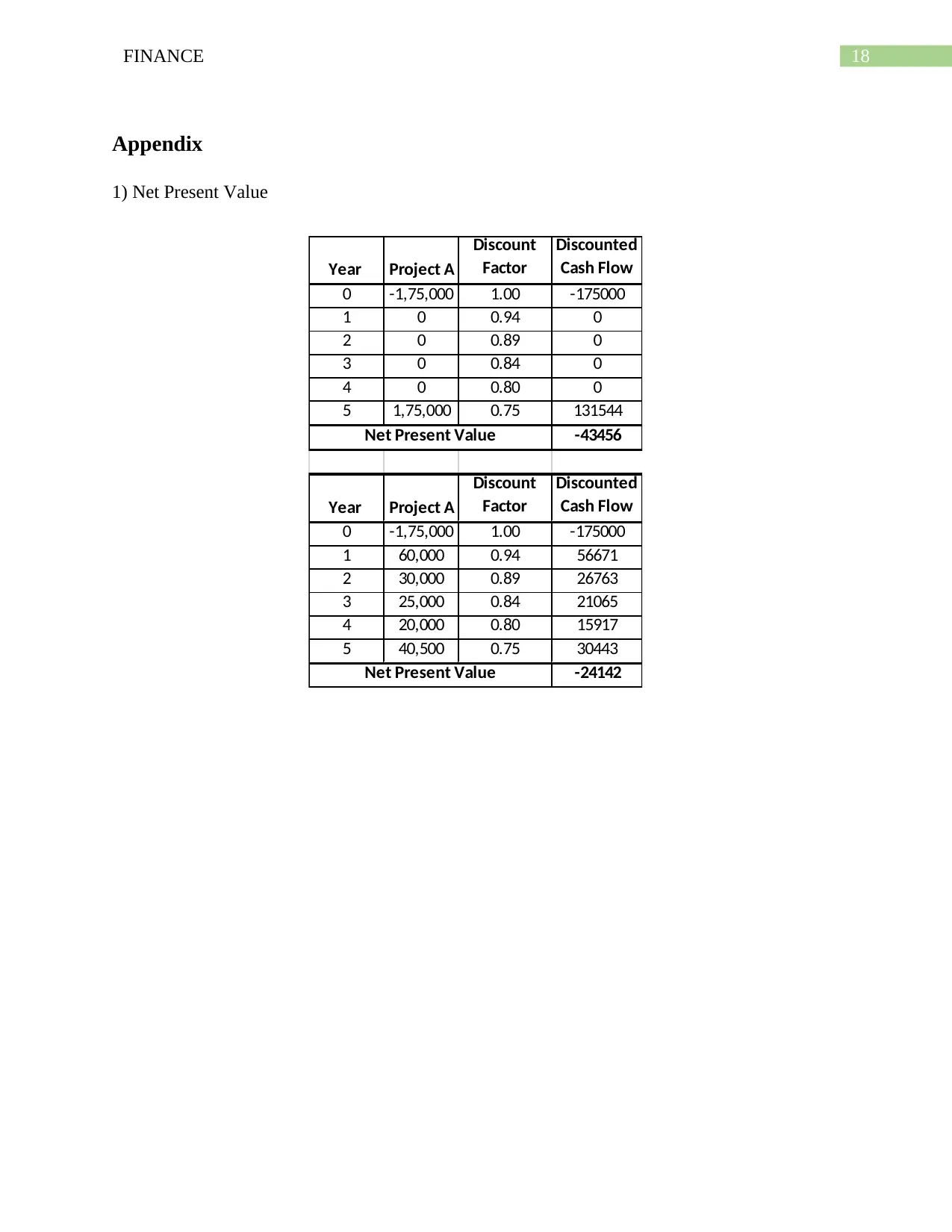
18FINANCE
Appendix
1) Net Present Value
Year Project A
Discount
Factor
Discounted
Cash Flow
0 -1,75,000 1.00 -175000
1 0 0.94 0
2 0 0.89 0
3 0 0.84 0
4 0 0.80 0
5 1,75,000 0.75 131544
-43456
Year Project A
Discount
Factor
Discounted
Cash Flow
0 -1,75,000 1.00 -175000
1 60,000 0.94 56671
2 30,000 0.89 26763
3 25,000 0.84 21065
4 20,000 0.80 15917
5 40,500 0.75 30443
-24142
Net Present Value
Net Present Value
Appendix
1) Net Present Value
Year Project A
Discount
Factor
Discounted
Cash Flow
0 -1,75,000 1.00 -175000
1 0 0.94 0
2 0 0.89 0
3 0 0.84 0
4 0 0.80 0
5 1,75,000 0.75 131544
-43456
Year Project A
Discount
Factor
Discounted
Cash Flow
0 -1,75,000 1.00 -175000
1 60,000 0.94 56671
2 30,000 0.89 26763
3 25,000 0.84 21065
4 20,000 0.80 15917
5 40,500 0.75 30443
-24142
Net Present Value
Net Present Value
Paraphrase This Document
Need a fresh take? Get an instant paraphrase of this document with our AI Paraphraser
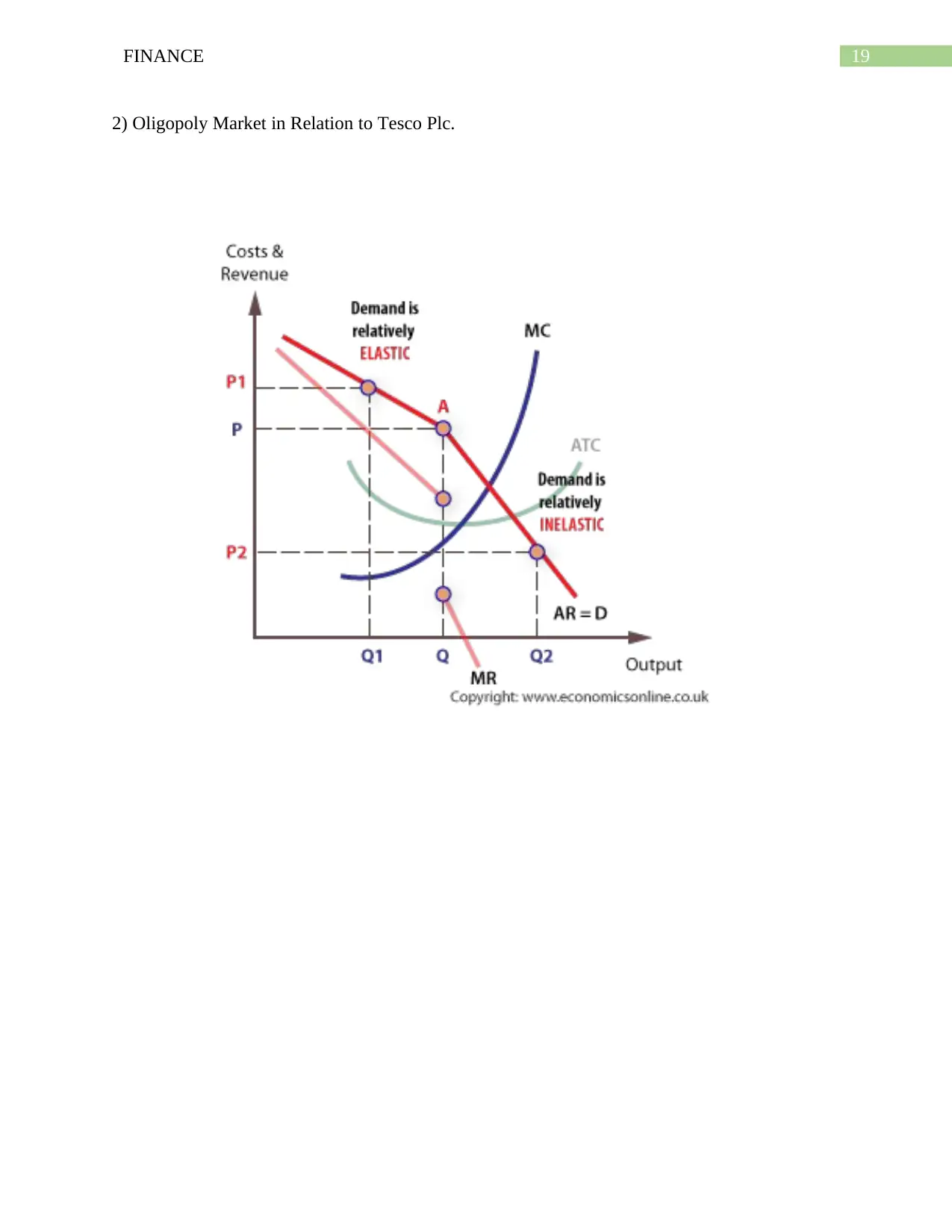
19FINANCE
2) Oligopoly Market in Relation to Tesco Plc.
2) Oligopoly Market in Relation to Tesco Plc.
1 out of 20
Related Documents
Your All-in-One AI-Powered Toolkit for Academic Success.
+13062052269
info@desklib.com
Available 24*7 on WhatsApp / Email
![[object Object]](/_next/static/media/star-bottom.7253800d.svg)
Unlock your academic potential
© 2024 | Zucol Services PVT LTD | All rights reserved.





